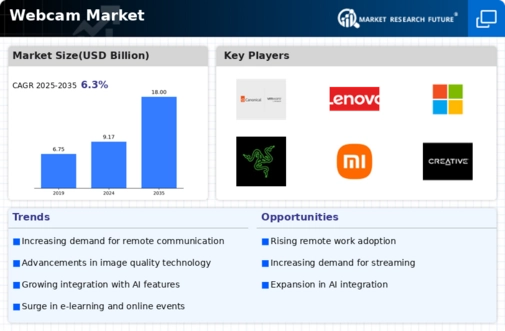Growing E-Learning Sector
The Webcam Market is experiencing growth driven by the expanding e-learning sector. As educational institutions increasingly adopt online learning platforms, the demand for webcams has surged. Recent statistics indicate that the e-learning market is projected to reach a valuation of over 300 billion dollars by 2025, highlighting the critical role of webcams in facilitating remote education. High-quality webcams are essential for delivering interactive and engaging learning experiences, allowing educators to connect with students effectively. This trend has prompted manufacturers to focus on developing webcams that cater specifically to the needs of educators and students, incorporating features such as high-definition video, built-in microphones, and compatibility with various online learning tools. The Webcam Market is thus positioned to capitalize on the growing emphasis on digital education.
Surge in Content Creation
The Webcam Market is significantly influenced by the rising trend of content creation across various platforms. With the proliferation of social media and streaming services, individuals and businesses are increasingly investing in high-quality webcams to produce engaging content. Data indicates that the number of content creators has doubled in recent years, leading to a heightened demand for webcams that deliver exceptional video quality and performance. This trend is particularly evident among gamers, vloggers, and educators who require reliable equipment for live streaming and online tutorials. As a result, manufacturers are innovating to provide advanced features such as 4K resolution, low-light performance, and integrated software solutions. The Webcam Market is thus positioned to benefit from this growing community of content creators seeking to enhance their production quality.
Integration of Artificial Intelligence
The integration of artificial intelligence (AI) into webcam technology is emerging as a transformative driver within the Webcam Market. AI capabilities enable features such as facial recognition, background blurring, and automatic framing, which enhance user experience and functionality. This technological advancement is particularly appealing to professionals who require seamless video quality during virtual meetings. Market analysis suggests that the adoption of AI-driven webcams is expected to increase by over 20% in the coming years, as users seek devices that can adapt to their environments and improve video clarity. Furthermore, the incorporation of AI can lead to more efficient bandwidth usage, making it a compelling choice for users in areas with limited internet connectivity. The Webcam Market is thus evolving to meet the demands of a tech-savvy audience that values innovation.
Increased Demand for Video Conferencing
The Webcam Market experiences a notable surge in demand for video conferencing solutions. As organizations increasingly adopt remote work policies, the necessity for high-quality webcams has become paramount. According to recent data, the video conferencing segment is projected to grow at a compound annual growth rate of approximately 15% over the next five years. This growth is driven by the need for effective communication tools that facilitate collaboration among remote teams. Consequently, manufacturers are focusing on developing webcams that offer superior video quality, enhanced audio features, and user-friendly interfaces. The Webcam Market is thus witnessing innovations aimed at meeting the evolving needs of businesses and individuals alike, ensuring that video conferencing remains a viable alternative to in-person meetings.
Rising Popularity of Telehealth Services
The Webcam Market is significantly impacted by the increasing popularity of telehealth services. As healthcare providers expand their offerings to include virtual consultations, the demand for reliable webcams has intensified. Data suggests that the telehealth market is expected to grow at a rate of approximately 25% annually, driven by the need for accessible healthcare solutions. Webcams play a crucial role in enabling healthcare professionals to conduct remote consultations, ensuring that patients receive timely medical advice. This trend has led to innovations in webcam technology, with manufacturers focusing on features such as enhanced image quality and secure data transmission. The Webcam Market is thus adapting to meet the specific requirements of the healthcare sector, ensuring that telehealth services remain effective and user-friendly.

















Leave a Comment